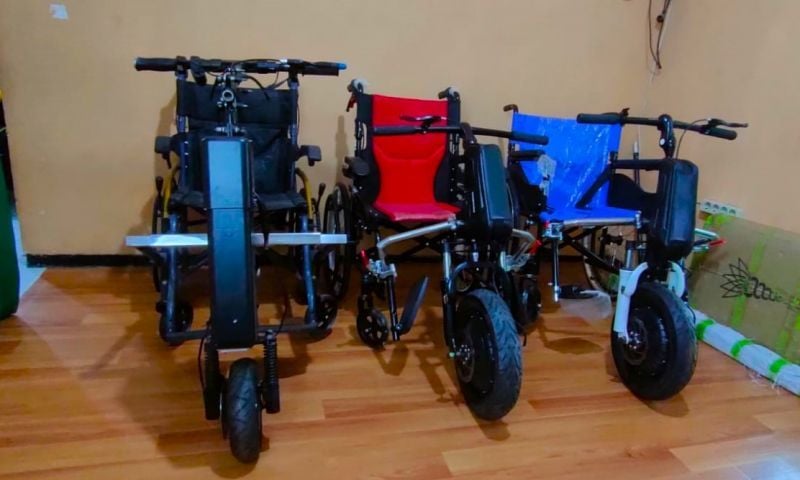Special for People with Disabilities and the Elderly, FT Team Designs Foldable Scooter and Electric Wheelchair

Unesa.ac.id, SURABAYA—To facilitate the daily activities of people with disabilities and the elderly, the Faculty of Engineering (FT) team at Universitas Negeri Surabaya (Unesa) has designed an electric foldable scooter and an electric wheelchair conversion kit.
This innovation was born from the hands of Agung Prijo Budijono, S.T., M.T., Akhmad Hafizh, Reza Rahmadian, I Gusti Putu, and their colleagues. The technology is the result of their collaboration with the industry under the Kedaireka scheme.
“Our goal is actually to make it easier for friends with disabilities and the elderly to be active or mobile. This initial enthusiasm made us feel the need to design a foldable scooter and an electric wheelchair,” said Agung.
The electric scooter is specially designed for these two groups. It is safe to use, practical, and ergonomic. The fork components are well arranged. Their electric scooter is 100 percent powered by electricity, so it does not emit smoke and does not cause noise.
Its speed ranges from 20–50 km per hour. There is even a scooter model that can reach 80 km per hour. Its maximum speed is on average 25 km per hour or 15 mph and can cover 40 km (25 miles) per charge.
This scooter weighs around 7–40 kg and can support a load of 100–200 kg. The electric scooter can be folded quickly, making it easy to store and carry around. In addition, their innovation has a twist-grip acceleration control, a 240W hub motor, and a lithium-ion battery that can be charged from a regular outlet.
The front lights are LED, there are brake calipers on each wheel, and a screen mounted in the middle of the handlebars shows the remaining power and speed. “Electric scooters can be a transportation option for short to medium distances,” he said.
Smart Wheelchair
The smart wheelchair designed by the team is equipped with a computer device, sensors, and other supporting technologies. “The main components of the wheelchair are the chassis, drive system (front, rear, mid-drive, or all-wheel drive), battery, and controller in the form of a hand or head joystick,” he explained.
This wheelchair is also equipped with other supporting technologies such as fingertip control (FTC), accelerometer, odometer, and head tilt. Additionally, there are pressure sensors installed in the seat to detect the distribution of the user's body pressure. “Pressure mapping with these pressure sensors is done in real-time,” he explained.

This product can move according to the user's body gestures and the pressure applied to the bottom of the seat. The control unit in the form of a "template" can change the user's posture to detect the desired movement.
He revealed that this electric wheelchair has sensors to detect human movement to trigger the motor's operation. Another important component to note in its model is the fork.
The fork is a component that connects the chassis unit on the e-folding scooter and the steering unit on the e-conversion kit wheelchair. The research designed by Agung and his colleagues focuses on optimizing the fork model to regulate stress distribution.
Just like the electric foldable scooter, the smart wheelchair also has various benefits for its users. Agung stated that this technology can increase independence because it does not require assistance or pushing from others.
Users can move more freely because it is easier to use than conventional wheelchairs. The use of this smart wheelchair is indeed easy because it is operated with electric technology, using levers to move forward, backward, and other directions. Users no longer need to manually turn the wheels.
"Through this electric-based technological breakthrough, it is hoped that it will become a tool that can facilitate the daily activities of the community, especially people with disabilities and the elderly," he hoped. []
***
Writer: Atika Febrina
Editor: @zam Alasiah*
Photo: Documentation of the FT UNESA Innovation Team
Share It On: